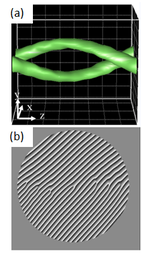Highlight
3D particle manipulation and tracking using computational optics
Achievement/Results
The use of optical forces to manipulate particles, molecules, and atoms affects fundamental physics, biophysics, and engineering. The introduction of holographic optical tweezers has further enabled the control of multiple optical traps in three dimensions (3D). As a consequence, new techniques are required to provide parallel, fast, and accurate particle tracking. A University of Colorado interdisciplinary team composed of electrical engineering and physics scientists developed a system that employs a 3D tailored optical response specifically designed for 3D localization and tracking named double-helix point spread function (DH-PSF) because of its 3D shape. The system generates two lobes that trace out a double helix by rotating around the optical axis as a particle moves out of focus. Depth is encoded through the rotation angle of the two lobes, while the lateral position can be estimated by calculating the centroid of the two lobes. The inherent axial asymmetry exhibited by the DH-PSF allows for fine discrimination between axial positions.
The system built by students supported through the National Science Foundation IGERT program uses an optical setup and matched estimation algorithms to attain 3D localization for multiple particles with nanometer precision. By integrating the DH tracking system with the holographic tweezers they demonstrated measurement of lateral and axial optical trap forces.
Address Goals
The characterization of the optical traps in three dimensions enables quantitative understanding of interaction forces in multiple biological and condensed matter systems that are inherently parallel and 3D. This discovery involves the use of mathematical, physical, and engineering sciences with implications in biophysical and biological research. The participating students were trained in advanced optical and computational techniques and experienced first hand the benefits of team work in an interdisciplinary environment







